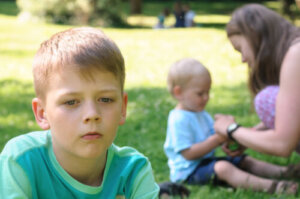6 Montessori Keys for Dealing with Jealousy Between Siblings


Written and verified by the psychologist Mara Amor López
Maria Montessori was a physician, educator, researcher, pedagogue, and psychologist of the early twentieth century and has become one of the great influences in the upbringing of children. There are many things we’ve come to learn from her and one of them has to do with dealing with jealousy between siblings.
Being able to intervene and improve the sibling relationship can be a huge relief in family life. So, here we’ll tell you how to manage jealousy and envy between siblings according to the Montessori method, no matter how old your children are. Don’t miss it!
Why does jealousy between siblings occur?
Jealousy usually appears when a sibling arrives in the family. It’s a feeling that the child experiences but doesn’t know how to explain and often expresses through inappropriate behavior. This can occur in different areas of their lives, such as, for example, a drop in their school grades.
For whatever reason, jealousy causes an obstacle in the relationship between siblings and one of them feels displaced from what they thought was their place in the family. For this reason, parents should be understanding, loving, and respectful of their children’s emotions and promote dialogue to improve this situation.
Just like happiness or sadness, jealousy is a natural emotion that the child must learn to manage. To do so, they must be able to decipher what’s happening to them and find a way to express it correctly. Therefore, it’s essential to take time to talk with the child before the arrival of a sibling, to keep the situation from worsening over time.
What signs indicate that there’s jealousy between siblings?
The appearance of some of the following signs could indicate that jealousy has appeared:
- Changes in the older child’s behavior.
- Lack of response to parental limits.
- Constant tantrums and emotional crises.
- Regressions to behaviors that no longer correspond to maturity. For example, wetting oneself after having achieved sphincter control.
- Imitation of what the younger sibling does.
- Aggressive behaviors and rejection of dialogue.
- Sleep disturbances and recurrent nightmares.
- Changes in appetite or eating habits.
- Manifestations of anxiety or low self-esteem.
Dealing with jealousy between siblings according to Maria Montessori

To prevent the appearance of jealousy in children who are expecting the arrival of a sibling, we can apply certain techniques that are based on the teachings of the Montessori method. We’ll show them to you below.
1. Involve the older sibling from the beginning of the pregnancy
One of the ways to prevent jealousy from appearing when the sibling is born, or at least to overcome this stage more quickly, is to involve them from the beginning of the pregnancy. We must tell them that we’re expecting a baby and that in a few months, a new member of the family will arrive whom we’ll have to love and take care of together.
The objective is for the child to perceive this situation as something natural, but they shouldn’t be burdened with responsibilities that don’t belong to them.
2. Don’t create false expectations with the arrival of the new brother or sister
When we talk about the birth of a new sibling, we must do it realistically. Don’t convey the message that everything’s going to be perfect or even negative. The best thing to do is to be sincere and explain what the arrival of a new member in the house represents, using vocabulary according to the child’s age. Also, encourage them to ask us their questions about this event.
3. Don’t compare siblings
Regardless of their age, siblings should never be compared. Making distinctions, whether positive or negative, only damages self-esteem and increases jealousy.
4. Reaffirm the role of each sibling
We must give each sibling independence and let them have their own space. They themselves must put into practice those new abilities, even if they fail in many of them. We mustn’t forget that we learn more from mistakes than from successes.

5. Let the older sibling participate in helping care for the younger sibling as much as possible
We can count on the assistance of the sibling when changing the baby’s clothes or preparing the bath. When they’re older, we can also encourage the older one to accompany the younger one to school or help them with their homework, among other activities.
No matter how old your children are, knowing that they can always count on the help of their brother or sister will help them to strengthen their relationship.
6. Intervene appropriately in the face of calls for attention
It’s possible that older siblings may constantly seek attention due to jealousy, or the other way around. In any case, whenever one of them demands the attention of their parents, the best thing we can do is give it to them. Therefore, it’s important to dialogue with the children, look for moments to share all together, and also, dedicate time exclusively to each of your children. It’s crucial that all children understand that they don’t need to make “noise” for their parents to want to spend time with them.
About the keys to dealing with jealousy between siblings according to Montessori
You’ve already seen how simple these techniques for dealing with jealousy between siblings are. Now, all that remains is to put them into practice so that the family situation improves. Patience, love, and respect are the keys to parenting and will be of great help, especially in the face of these expected crises in life.
Maria Montessori was a physician, educator, researcher, pedagogue, and psychologist of the early twentieth century and has become one of the great influences in the upbringing of children. There are many things we’ve come to learn from her and one of them has to do with dealing with jealousy between siblings.
Being able to intervene and improve the sibling relationship can be a huge relief in family life. So, here we’ll tell you how to manage jealousy and envy between siblings according to the Montessori method, no matter how old your children are. Don’t miss it!
Why does jealousy between siblings occur?
Jealousy usually appears when a sibling arrives in the family. It’s a feeling that the child experiences but doesn’t know how to explain and often expresses through inappropriate behavior. This can occur in different areas of their lives, such as, for example, a drop in their school grades.
For whatever reason, jealousy causes an obstacle in the relationship between siblings and one of them feels displaced from what they thought was their place in the family. For this reason, parents should be understanding, loving, and respectful of their children’s emotions and promote dialogue to improve this situation.
Just like happiness or sadness, jealousy is a natural emotion that the child must learn to manage. To do so, they must be able to decipher what’s happening to them and find a way to express it correctly. Therefore, it’s essential to take time to talk with the child before the arrival of a sibling, to keep the situation from worsening over time.
What signs indicate that there’s jealousy between siblings?
The appearance of some of the following signs could indicate that jealousy has appeared:
- Changes in the older child’s behavior.
- Lack of response to parental limits.
- Constant tantrums and emotional crises.
- Regressions to behaviors that no longer correspond to maturity. For example, wetting oneself after having achieved sphincter control.
- Imitation of what the younger sibling does.
- Aggressive behaviors and rejection of dialogue.
- Sleep disturbances and recurrent nightmares.
- Changes in appetite or eating habits.
- Manifestations of anxiety or low self-esteem.
Dealing with jealousy between siblings according to Maria Montessori

To prevent the appearance of jealousy in children who are expecting the arrival of a sibling, we can apply certain techniques that are based on the teachings of the Montessori method. We’ll show them to you below.
1. Involve the older sibling from the beginning of the pregnancy
One of the ways to prevent jealousy from appearing when the sibling is born, or at least to overcome this stage more quickly, is to involve them from the beginning of the pregnancy. We must tell them that we’re expecting a baby and that in a few months, a new member of the family will arrive whom we’ll have to love and take care of together.
The objective is for the child to perceive this situation as something natural, but they shouldn’t be burdened with responsibilities that don’t belong to them.
2. Don’t create false expectations with the arrival of the new brother or sister
When we talk about the birth of a new sibling, we must do it realistically. Don’t convey the message that everything’s going to be perfect or even negative. The best thing to do is to be sincere and explain what the arrival of a new member in the house represents, using vocabulary according to the child’s age. Also, encourage them to ask us their questions about this event.
3. Don’t compare siblings
Regardless of their age, siblings should never be compared. Making distinctions, whether positive or negative, only damages self-esteem and increases jealousy.
4. Reaffirm the role of each sibling
We must give each sibling independence and let them have their own space. They themselves must put into practice those new abilities, even if they fail in many of them. We mustn’t forget that we learn more from mistakes than from successes.

5. Let the older sibling participate in helping care for the younger sibling as much as possible
We can count on the assistance of the sibling when changing the baby’s clothes or preparing the bath. When they’re older, we can also encourage the older one to accompany the younger one to school or help them with their homework, among other activities.
No matter how old your children are, knowing that they can always count on the help of their brother or sister will help them to strengthen their relationship.
6. Intervene appropriately in the face of calls for attention
It’s possible that older siblings may constantly seek attention due to jealousy, or the other way around. In any case, whenever one of them demands the attention of their parents, the best thing we can do is give it to them. Therefore, it’s important to dialogue with the children, look for moments to share all together, and also, dedicate time exclusively to each of your children. It’s crucial that all children understand that they don’t need to make “noise” for their parents to want to spend time with them.
About the keys to dealing with jealousy between siblings according to Montessori
You’ve already seen how simple these techniques for dealing with jealousy between siblings are. Now, all that remains is to put them into practice so that the family situation improves. Patience, love, and respect are the keys to parenting and will be of great help, especially in the face of these expected crises in life.
All cited sources were thoroughly reviewed by our team to ensure their quality, reliability, currency, and validity. The bibliography of this article was considered reliable and of academic or scientific accuracy.
- Montessori, M., & Bofill, M. (1986). La mente absorbente del niño. Diana.
- Dattari, C., Bonnefont, J., Falcone, C., Giangrandi, B., Mingo, G., Naretto, D., & Souper, C. (2017). El Método Montessori. Teoría de la educación. En internet: https://d1wqtxts1xzle7.cloudfront.net/54740567/Montessori_FINAL-with-cover-page-v2.pdf?Expires=1659358873&Signature=O9LKih-xEY1yiXM6oiM4FQNL4IYR5Z1i7JBwHgbk-jGiGMrojvQOWP3D~aha5iWYydh-rW-3-WYc53W6EGleof0VG8XqN7DGGTCftLpRSwivk44eK1HwdIboduczRHdhkM~ags91OqSWbN6nN63ebfKlGW~4d5NSHOJ2SdSPF4HFtQCtF6~6ZhP-XP7VjZ1RSOlKXowOPSmsmIyqH4GiAOr~BmxxW-g1QUollZ3YFhXDBTtr0JuhDsKAPPd0QfZcmPPgSwxdpMMlh-KxE6BYln-Dcn4VSQ4Fr8gBP~mI~1tTg6UybgzRLx6wXcDZPtj5R9s6qjLMxIGCvjSHWYmS~Q__&Key-Pair-Id=APKAJLOHF5GGSLRBV4ZA
This text is provided for informational purposes only and does not replace consultation with a professional. If in doubt, consult your specialist.








